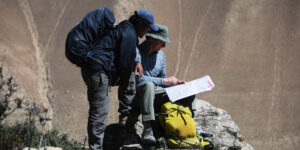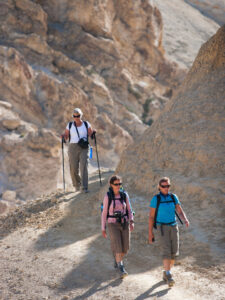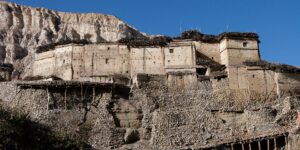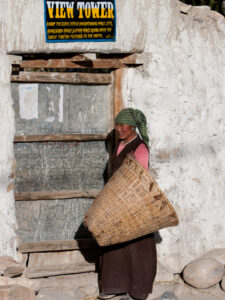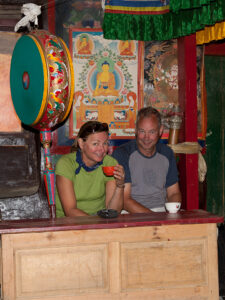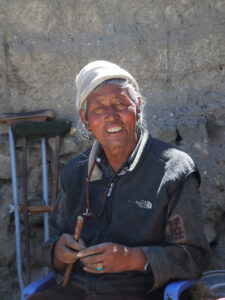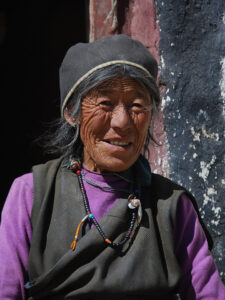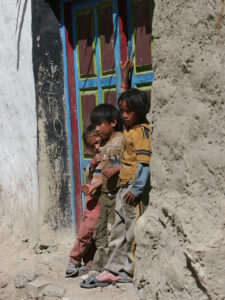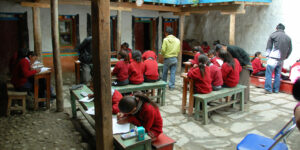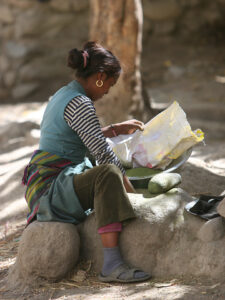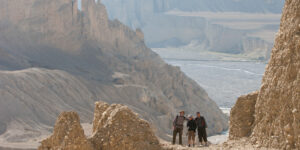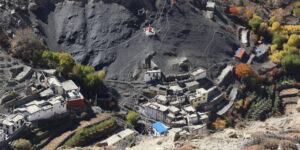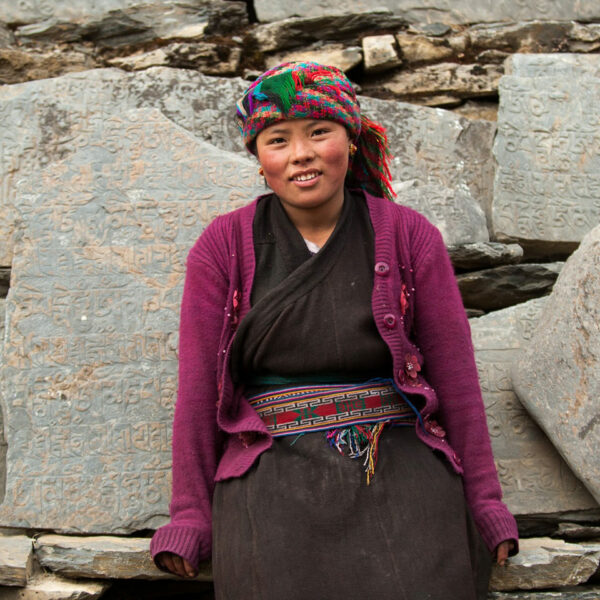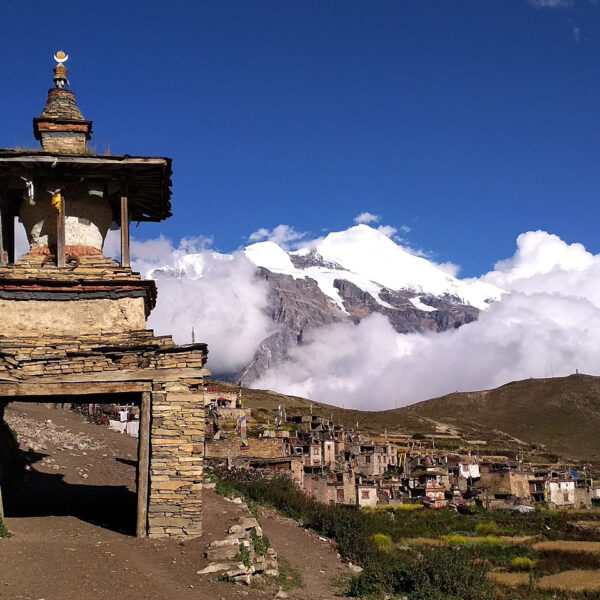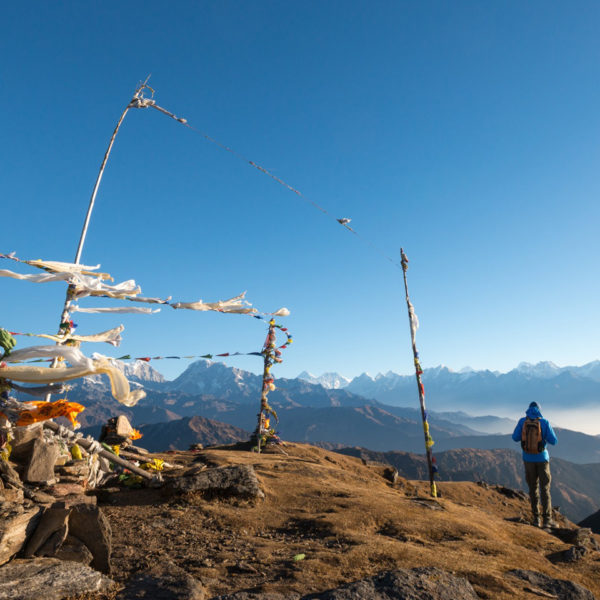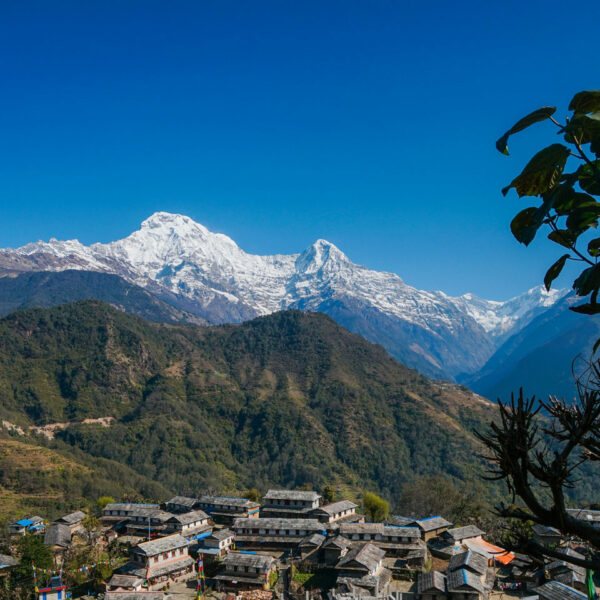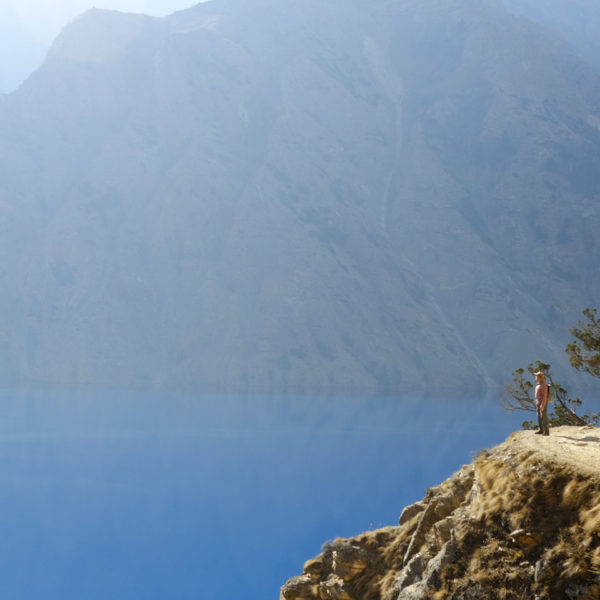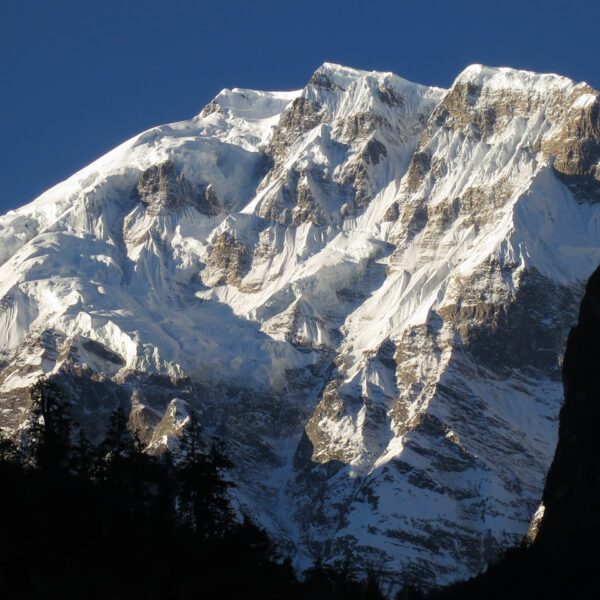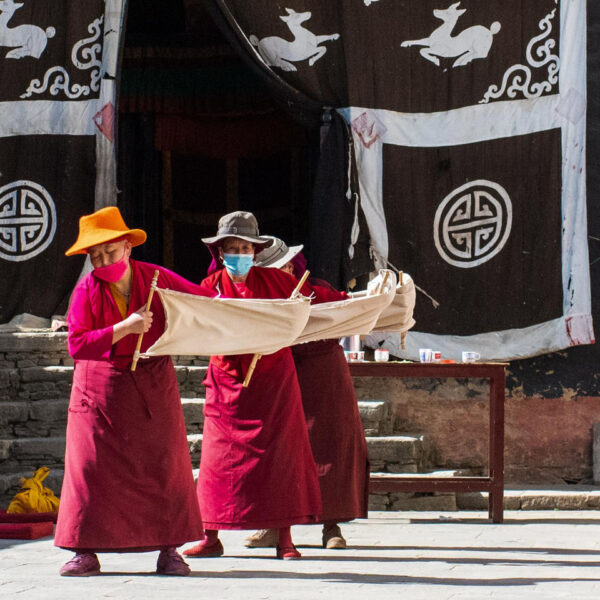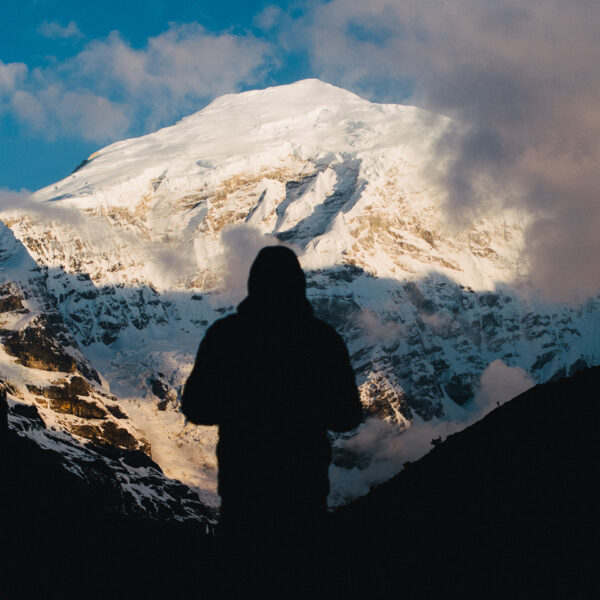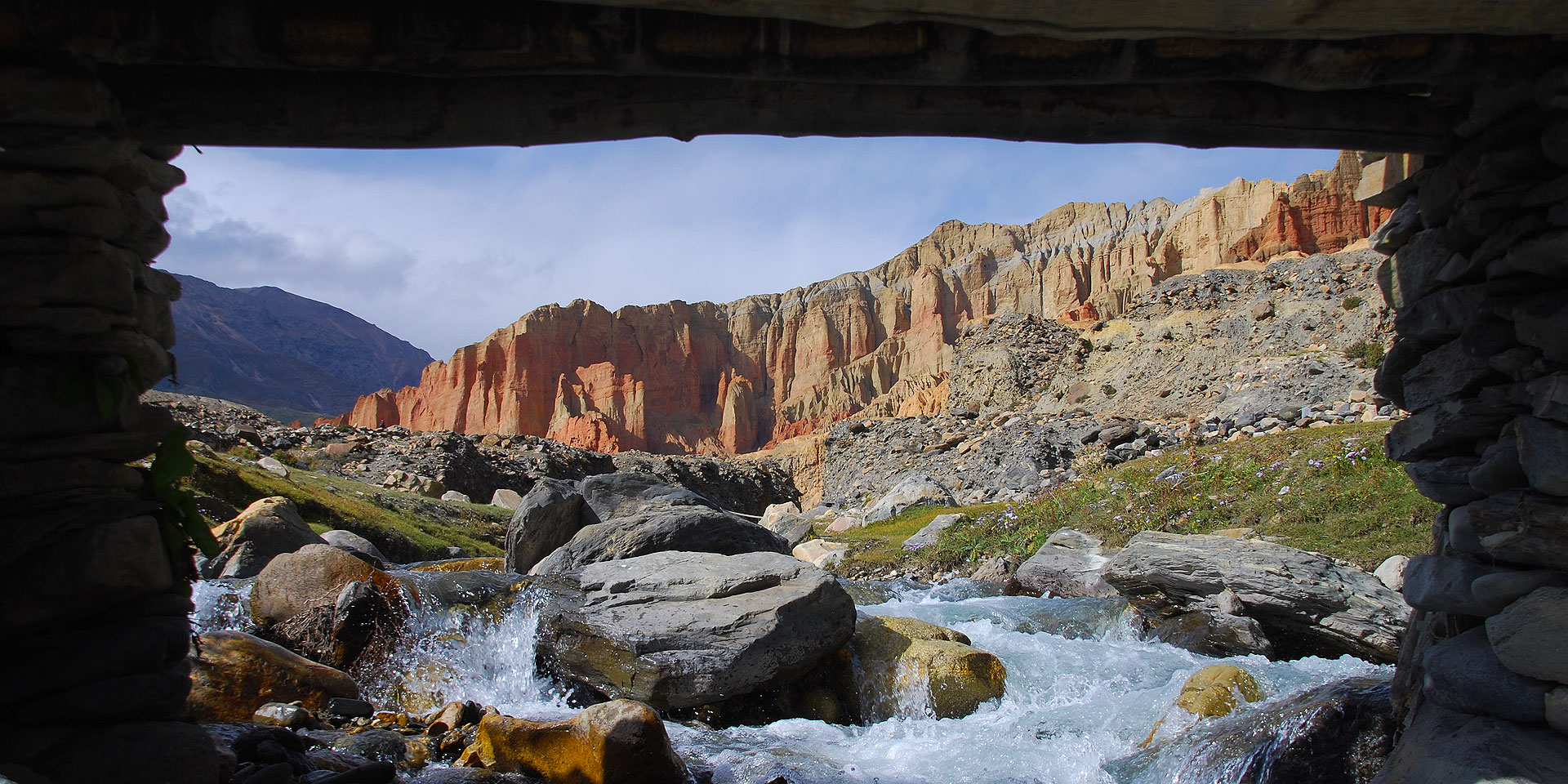
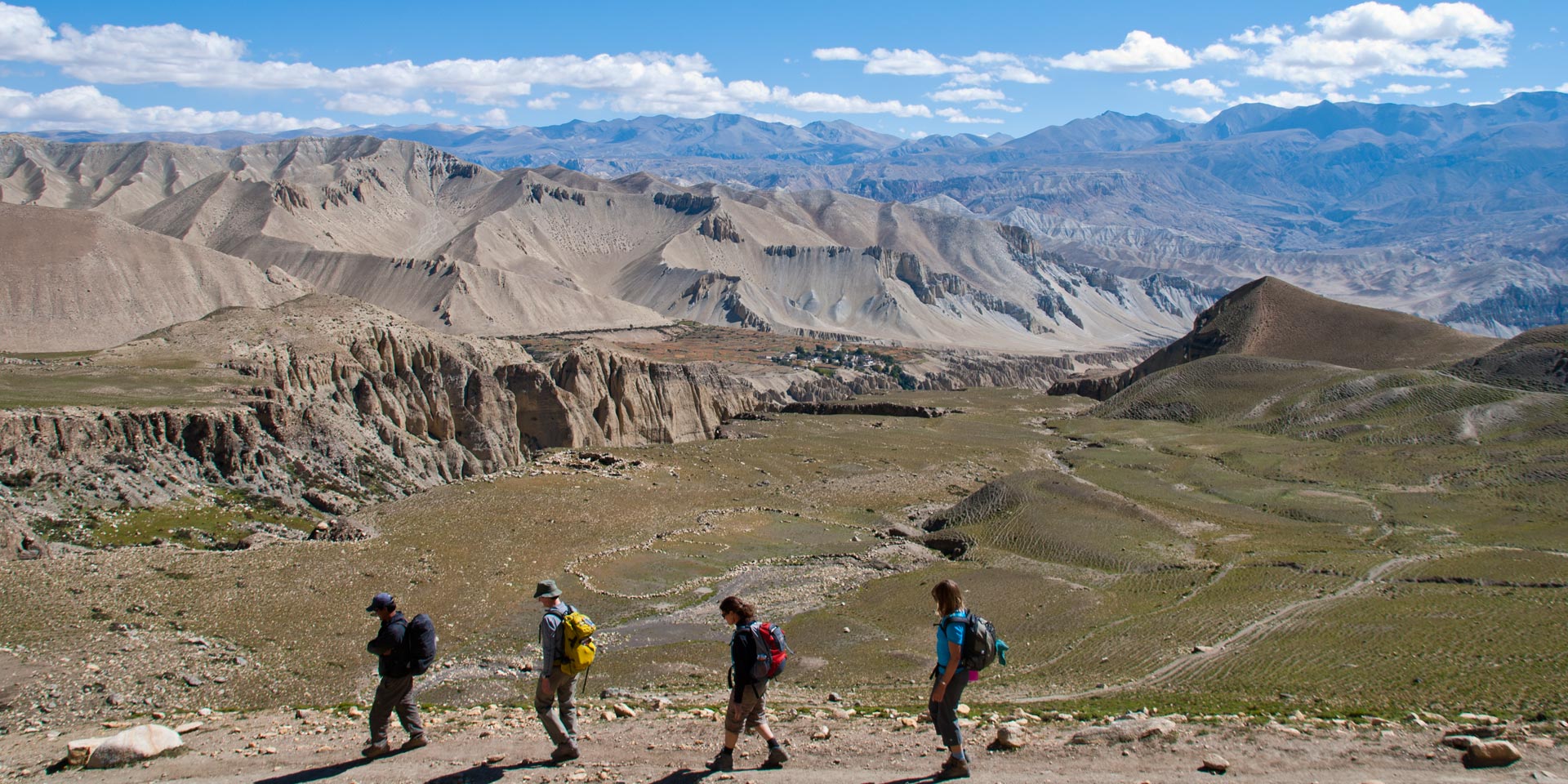
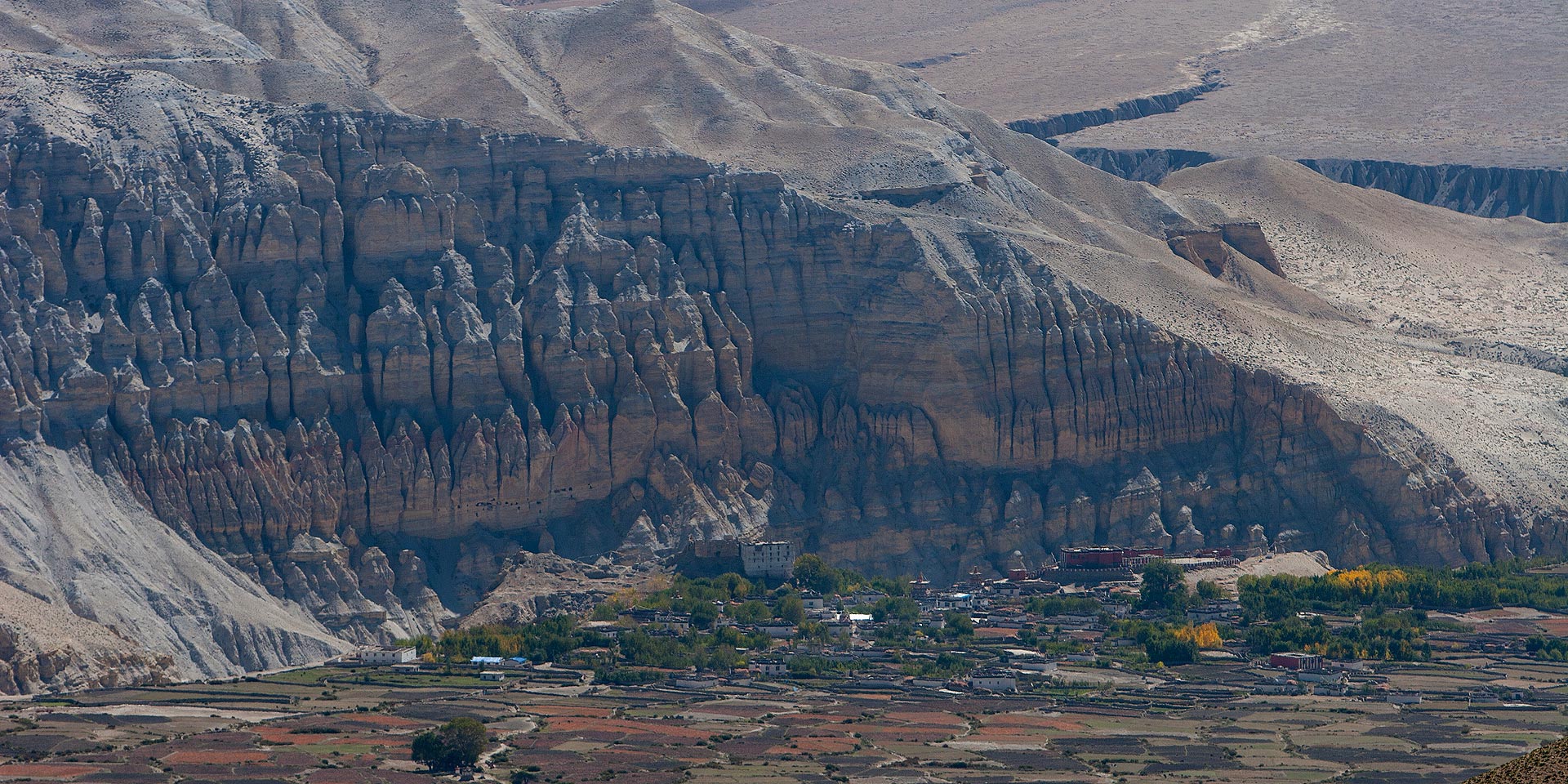
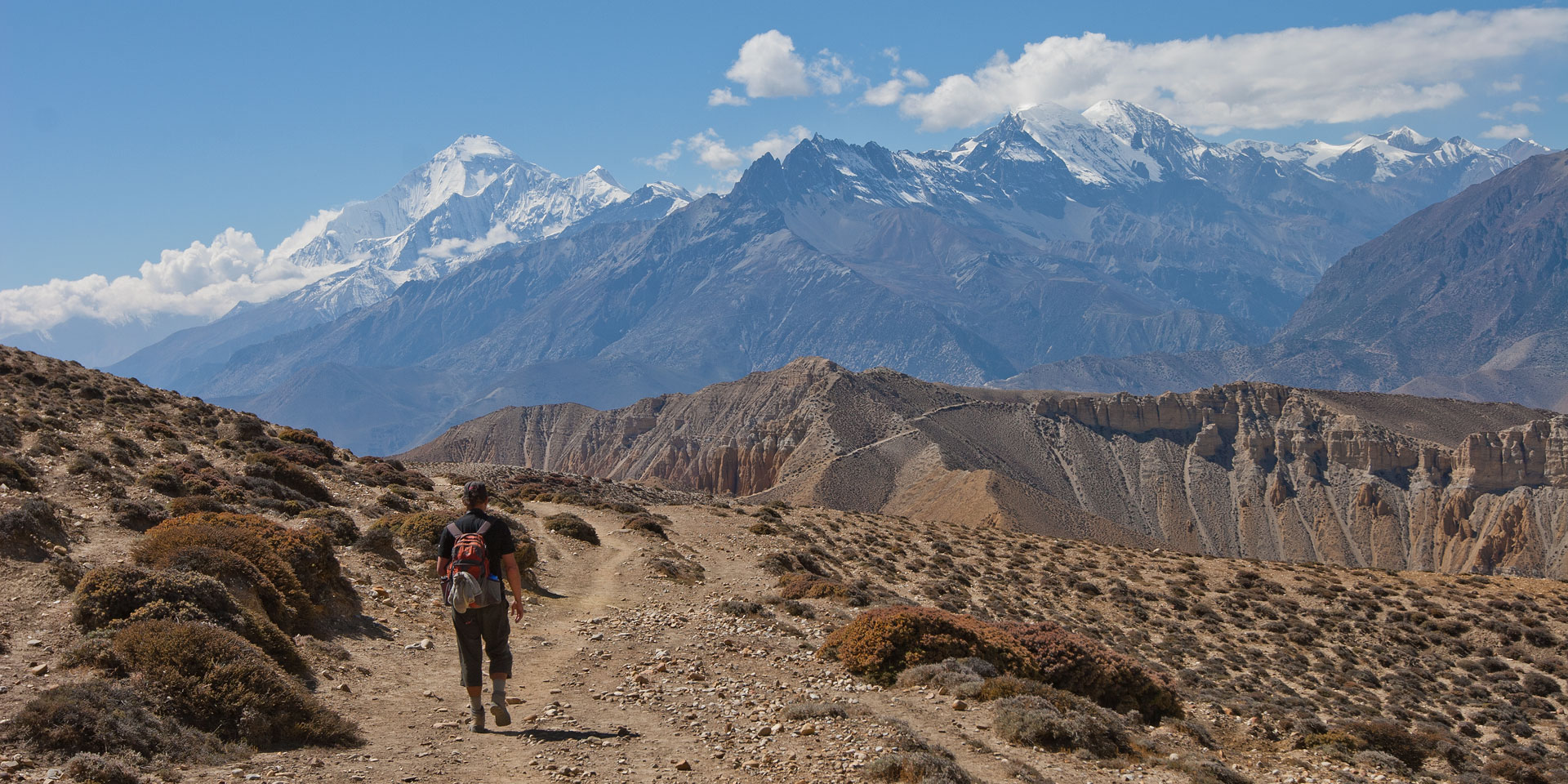
Best of Upper Mustang
Starting from US$ 2880.00
A timeless and breathtaking journey through the Kingdom of Lo, until relatively recently a hidden Tibetan Buddhist enclave forbidden to foreigners. Sculpted canyons with wild rock formations, deep gorges, medieval villages, ancient fortresses, palaces and mysterious, ancient cave hermitages, Tibetan Buddhist gompas and soaring snow-peaks characterise this spectacular region, a ‘thumb’ sticking up from Nepal into the Tibetan plateau.
We have designed this itinerary to avoid the roads that now run down the western side of the valley and when we cannot avoid them, we use them to drive on instead of hiking. This means we trek the best parts of Upper Mustang which is still out of this world in terms of culture and scenery. We have enough time built into the itinerary so if there are any flight delays we can drive instead and not loose out on seeing all of the great places in Upper Mustang. These treks are lead by Gelu Sherpa who knows Upper Mustang like the back of his hand and loves to this magical place to you the visitor!
- Starts In: Kathmandu
- Ends In: Kathmandu
- Duration: 18 Days
- Difficulty Grade: Demanding
Highlights
- Explore the stunning expanse of high desert, with a backdrop of the high Himalaya
- Incredible culture of the once forbidden kingdom
- Arid Tibetan plateau terrain, rock formations and stunning gorges
- rarely visited Konchokling cave
- Lo Manthang last functioning walled city
Itinerary
Day 01: Arrive Kathmandu [1350m]
As we fly into Kathmandu, we’ll have beautiful views over the city, the Himalaya, and of the terraced fields below. After going through customs, a representative will be waiting to greet us and guide us through the initial culture shock of Kathmandu’s narrow, winding streets to get us settled into our hotel.
In the evening, the tourist hub of Thamel is a good place to grab our first meal, with a variety of restaurants to choose from offering both Western and local Nepali dishes.
Accommodation: Hotel Thamel House
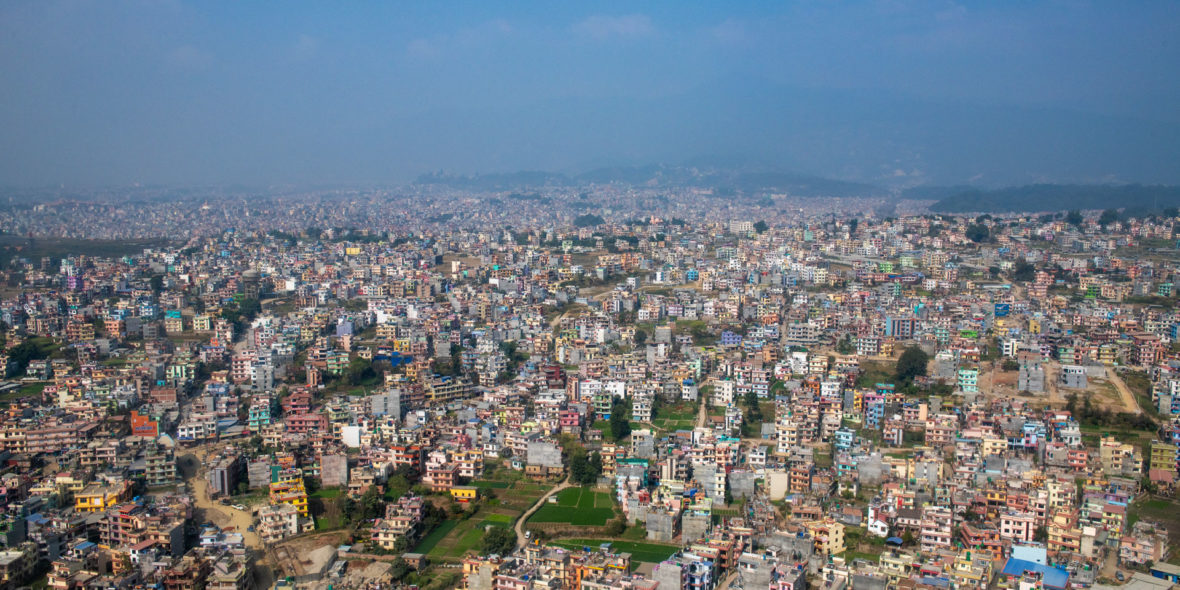
Day 02: Fly to Pokhara [827m]
Today we’ll get transferred to the domestic airport to catch our flight to Pokhara. This is a stunning half hour flight along the Himalayan Range, seeing four of the world’s fourteen giant mountains over 8000m; Dhaulagiri, Annapurna I, Manaslu and Shishapangma, before landing in the charming, lakeside town of Pokhara. The afternoon here is free to explore a bit of the town on our own or just relax but the lake or in our hotel.
Accommodation: Lake Side Retreat
Meals included:
Breakfast

Day 03: Fly to Jomsom and Drive to Kagbeni [2800m]
We are up early this morning for your spectacular mountain flight to the district headquarters of Mustang, Jomsom. We take off from Pokhara and fly through the deepest gorge in the World. From our vantage point in the plane, the views of Dhaulagiri and Annapurna are truly stunning. 18 minutes later we touch down in a totally different world, the arid valleys of the Himalayan rain shadow. Jomsom is among the very few places in Nepal from where the Himalayan peaks can be admired at such a close range and yet from a safe altitude of only 8800 feet. Giant peaks like Nilgiri, Tilicho and Dhaulagiri seem so close we could reach out to touch them.
Once on the ground, at 2710 meters, we will feel how much cooler and drier the air is! We head north to Kagbeni, along the wide trail along the western side of the sandy, saligram-filled riverbed, reaching there in time for lunch.
Kagbeni, spectacularly situated atop a cliff overlooking the confluence of the Kali Gandaki and the Jhong Khola rivers, is the last village in Lower Mustang and guards the entrance into Upper Mustang, visible across the Kali Gandaki riverbed. It is an oasis of green fields in the midst of rocky, arid mountains, with Niligiri looming grandly behind it. This ancient, partially ruined citadel town provides an incredible insight into a unique way of life, with its narrow alleyways and tunnels, irrigation canals, green fields of barley and its massive, brick-red Sayka Gompa, an amazing 800 years old. We can also enjoy wandering past and wondering about the ancient 100-room King’s Palace. At the police check post at the north end of the village there is a sign that reads ‘Restricted area, tourists please do not go beyond this point’. This is the trail going up to the famous Lo Manthang, in ‘forbidden’ Upper Mustang.
Driving time: Approx. 1 hours
Accommodation: Local Tea House
Meals included:
Breakfast, Lunch, Dinner

Day 04: Day trip to Muktinath
Muktinath is a holy place where both water and flames come from the side of the mountain. It is one of the most important pilgrimage sites of Nepal for both Buddhists and Hindus. It is a great example of a sacred place shared in harmony by devotees of two religions. The traditional caretakers are the Muktinath Nuns of the lineage of Lama Wangyal.
Every year, thousands of devotees from Nepal, India and Tibet come on pilgrimage for purification and salvation and it is said that throughout history many Kings throughout Asia did the same. It is worth spending a day up here to not only visit this sacred shrine but also to relax and savour simply being here in the mountains.
This is a day both for acclimatising but also a contingency day just in case we have had to drive up here due to flight cancellations.
Driving time: Approx. 1 hours
Walking time: Approx. 3 hours
Accommodation: Local Tea House
Meals included:
Breakfast, Lunch, Dinner
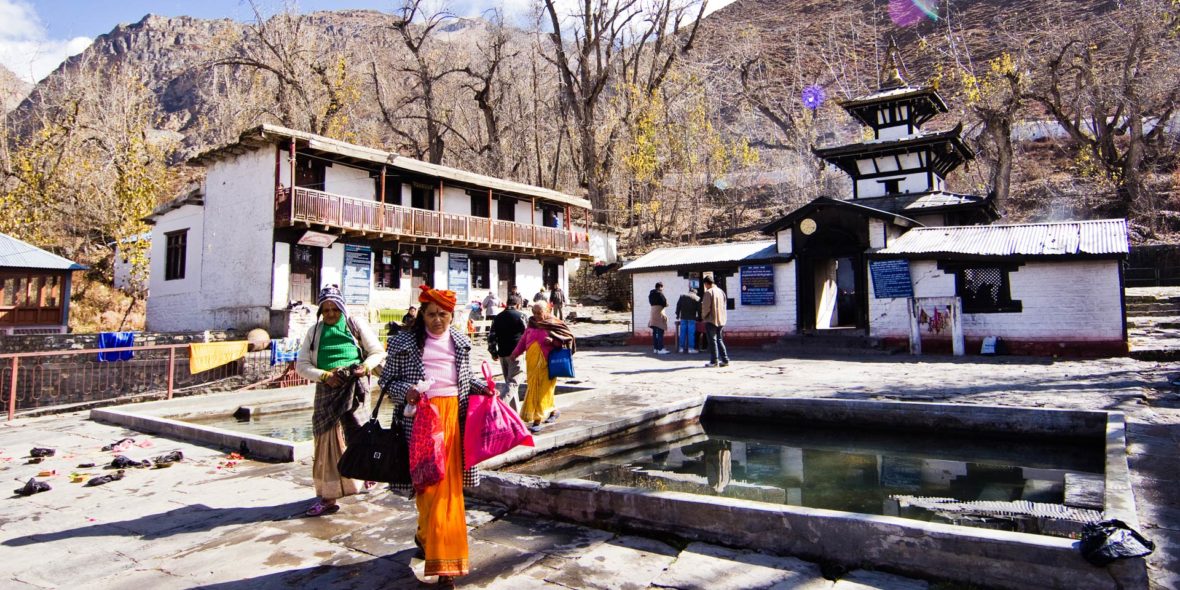
Day 05: Drive to Samar, Trek to Chungtsi Cave, Drive to Ghiling [3570m]
After a hearty breakfast head out in the car this morning, until getting to Samar. We then hit the trekking trail, passing through the cluster of traditional houses and main walls of Samar, we exit through the ‘kane’ chorten and descend steeply on a switch backing trail to the Samarkyung Khola, after which we have another drop into the next valley, the Jhuwa Khola, and another climb out. At the plateau we take the right fork and continue to climb for a short time to the Chungsi La (3810m), from where we’re treated to spectacular views down into the deep canyon beyond us, and back over the Annapurnas.
Again switch backing steeply, we drop into this incredible, vast canyon, with wonderful, expansive views the entire time. Staying high above the Kali Gandaki, which snakes its way through the canyons far, far below us, the trail descends steeply, eventually rounding the corner just past our large look-out rock. It doesn’t take long to round the corner and reach the intersection to the sacred Buddhist Chungsi Caves, about 500 meters below the pass. The Chungsi Caves, about 300 steps up, are one of the ubiquitous Guru Rimpoche’s meditation caves. Inside are fantastic ‘rangjung’ or self-created Tibetan Buddhist sculptures, chortens, ‘Tara’s terraced fields’ and others Buddhist relics.
Back down the steps, we continue to head north, climbing back up through the canyon on a widened trail towards our destination. A steep switch-back leads to the small hamlet of Shyangmochen (3765m) and up to the Shyangmochen La, where the trail intersects a wide east-west valley. From here it is a quick descent to the picturesque village of Geling. There is an old gompa above the village, ancient meditation caves in the eroded cliffs visible above and traditional Mustangi houses surrounded by barley fields.
Walking time: Approx. 7 hours
Accommodation: Local Tea House
Meals included:
Breakfast, Lunch
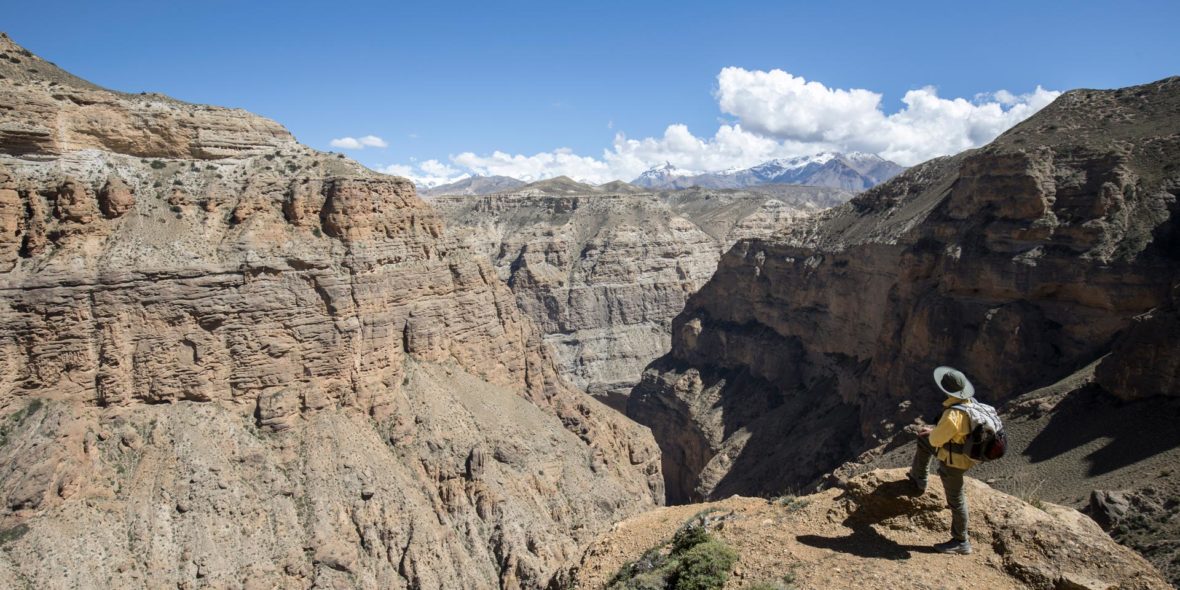
Day 06: Drive to Ghami La, Trek to Dhakmar via Ghami [3750m]
Another drive out of town this morning gets us to our trailhead, where we’ll head down to a bridge crossing the Tangmar Chu river. From here, the trail looks across the valley to ochre, blue and steel-grey cliffs, and leads you past the tri-colored stupas so characteristics of the Kingdom of Lo to what is said to be the longest and most spectacular mani wall in Nepal. Looming ahead of you is a cluster of gigantic, ancient chortens, backed by dramatic, sculpted cliff-faces… truly an awesome sight!
From here we’ll pass a sky burial site as we turn up the river towards Dhakmar. We’ll trek past an ancient set of huge chortens and on past the stunning red, ochre and yellow cliffs up along the stream to the gorgeously set village of Dhakmar, nestled under the huge red cliffs. The color of the cliffs, the chortens, and the mani wall are all critical landmarks inseparable from the story of the bringing of Buddhism to Tibet – it is said that Guru Rinpoche came to this place to defeat a demoness who was preventing the construction of Tibet’s first monastery. The red hue here represents her blood spilling across the landscape and, according to legend, the mani wall holds down her intestines!
Walking time: Approx. 2-3 hours
Accommodation: Local Tea House
Meals included:
Breakfast, Lunch
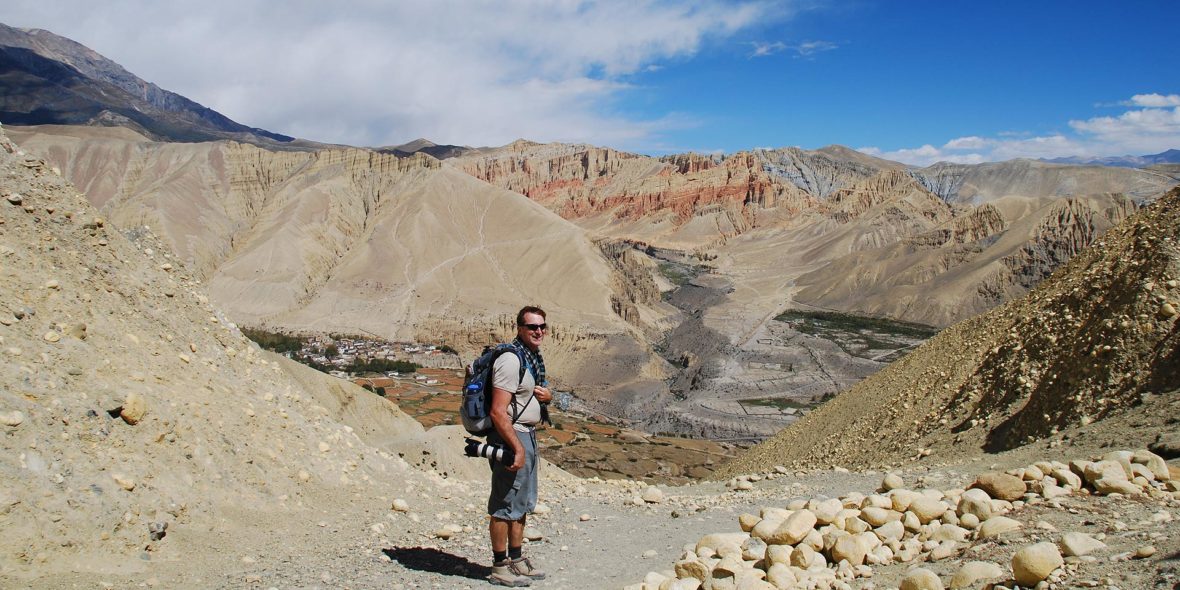
Day 07: Trek to Charang [3560m] via Mui La, Lo Gekar
After having our breakfast we’ll head to our next destination. From Dhakmar we have an incredible climb up through a steeply eroded and tunneled landscape to a crest overlooking the Dhakmar Valley. The scenery on this steep by stunning walk is truly wild. From the crest, the trail levels out somewhat with a much gentler ascent to the Mui La at 13,681 feet (4,170 m). From here we’ll have great views down to Marang and Tsarang.
We’ll drop down towards the Tsarang Khola and approach Lo Gekar (which means “pure virtue of Lo”) and the Ghar Gompa, built by the Guru Rinpoche, who brought Buddhism to Tibet. The first Monastery was to have been Samye in modern Tibet; however, the building was supposedly disturbed by demons, so the Guru came here to subdue them. Ghar Gompa was built to pin down the demon and clear the path for what we now know as Tibetan Buddhism. It’s truly humbling to visit this Gompa, knowing it was THE first Tibetan Buddhist monastery!
After lunch, we’ll head down the valley towards Tsarang, whose views we’ll enjoy along the way. We’ll cross the river and pass through a stunning chorten as we make our way up into the old town of Tsarang. In this large village, built on top of the Tsarang Khola canyon, we’ll find stone walls separating the houses and forming tunnel-like paths, with willow trees and an irrigation ditch, its own hydro-electric plant and quite a few guesthouses.
The village is dominated by the huge, five-story Tsarang Dzong, a Tibetan-styled fortified palace constructed in 1378; the large, ochre-hued Tsarang Gompa is said to have the greatest library in Lo. The dzong has a wonderful, old prayer room with a gold-printed prayer book and a fascinating array of statues, thankas and large Buddha paintings. Legend has it that the withered 500-year-old hand of the palace’s master architect is there!
In the afternoon, take a walk through the maze of paths to the dzong and friendly gompa before dinner and watch the local women herding their sheep through the narrow, walled paths as dusk falls.
Walking time: Approx. 6 hours
Accommodation: Local Tea House
Meals included:
Breakfast, Lunch, Dinner
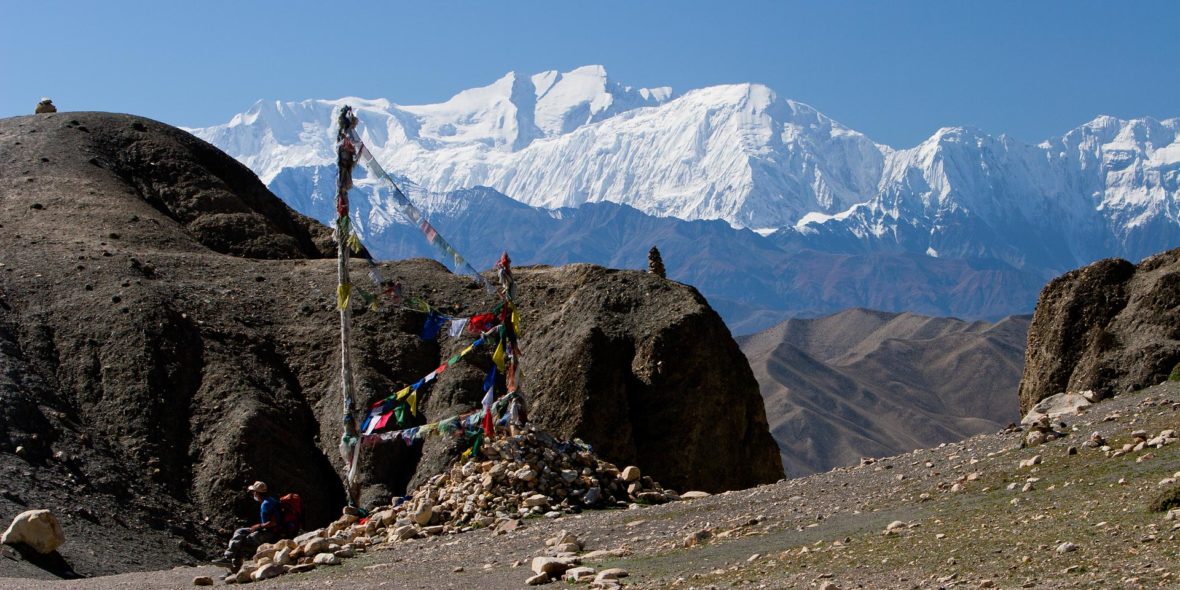
Day 08: Trek to Lo Manthang [3800m] via Manga La [4230m]
Leaving Tsarang on a trail leading down and across the Tsarang Khola, we climb steeply up a rocky trail to a cairn on the opposite ridge and then follow the Thuling Khola on the new, dirt road towards Lo. The multi-hued canyons spread themselves impressively around us, and the landscape becomes very Tibetan in character; the high desert expanses north of the Himalaya. We start to see a few snow peaks ahead of us as we near the Manga La (La means pass), at 4230 meters. The pass leads through a partial tunnel of rock, and to the right of this are strung Tibetan prayer flags. Climb to the ridge to the right for wonderful views down to Lo Manthang and the aptly named ‘Plain of Aspiration’, below us.
The fabled walled city of Lo Manthang, with a single entrance through which only the King, Queen and Kempo (Abbot) are allowed to ride – all others must walk, to pay their respects to Chenrezig – is a mythical city.
There are four major temples within the medieval walls of Lo Manthang, the 14th century, brick-red Jampa Lhakhang (the oldest gompa, built in 1387, with the striking 50 foot ‘Jamba’ or Future Buddha, the largest clay statue in Nepal until a few years ago), 15th century Thubchen Gompa (great Assembly hall, pillars 30 feet high, the second oldest gompa with fantastic murals in the Dukhang), Chhoede Gompa (where the Khempo lives, with a monastic school) and Choprang Gompa.
There are 180 houses within the walls of the city which is inhabited by the Lo-ba (people of Lo), although many other Lo-bas now live outside the walls, since the King sold a lot of land there, many houses have sprung up. Many of the Lo-ba still practice polyandry and it is well worth asking (sensitively) about how this system works.
Walking time: Approx. 3-4 hours
Accommodation: Local Tea House
Meals included:
Breakfast, Lunch, Dinner
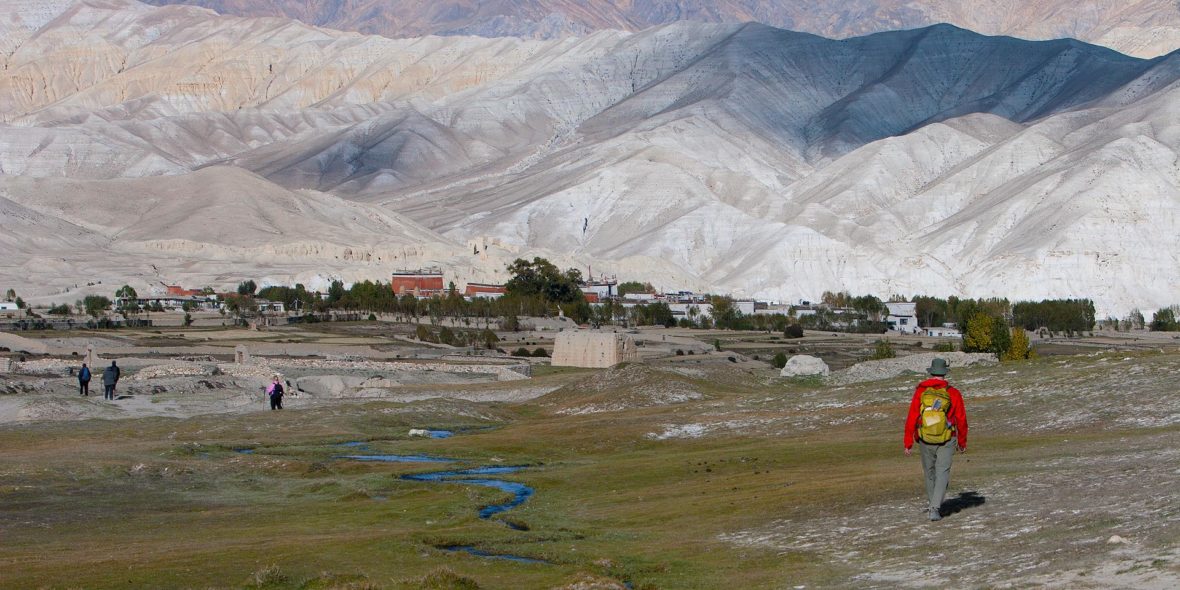
Day 09: Lo Manthang 3800m: Namgyal Gompa & the Thinggar Valley
This morning we’ll visit the monasteries in the old city — morning light is the best time to see the religious artwork, as it gets much darker once the sun is high in the sky. Bring a flashlight with you, but please note that photography is forbidden inside monasteries (unless express permission has been given).
In the afternoon, explore the amazing land and culture around Lo. See the land by horseback or just relax or wander the city’s intriguing streets. Check out the town’s Tibetan herbal medicine clinic (run by an Amchi), two schools, new stores, and a coffee shop.
We can also head up along the valley northwest of Lo to the active Namgyal Gompa (the Monastery of Victory), set spectacularly on top of a desolate ridge. You’ll notice that the design here differs from those of the gompas in Lo. There are some ancient ruins, gompas and old fortresses worth visiting if you head down to the stream, then up through an extensive, irrigated system of fields to the sprawling village of Thinggar, where the King also has his summer palace.
Accommodation: Local Tea House
Meals included:
Breakfast, Lunch, Dinner
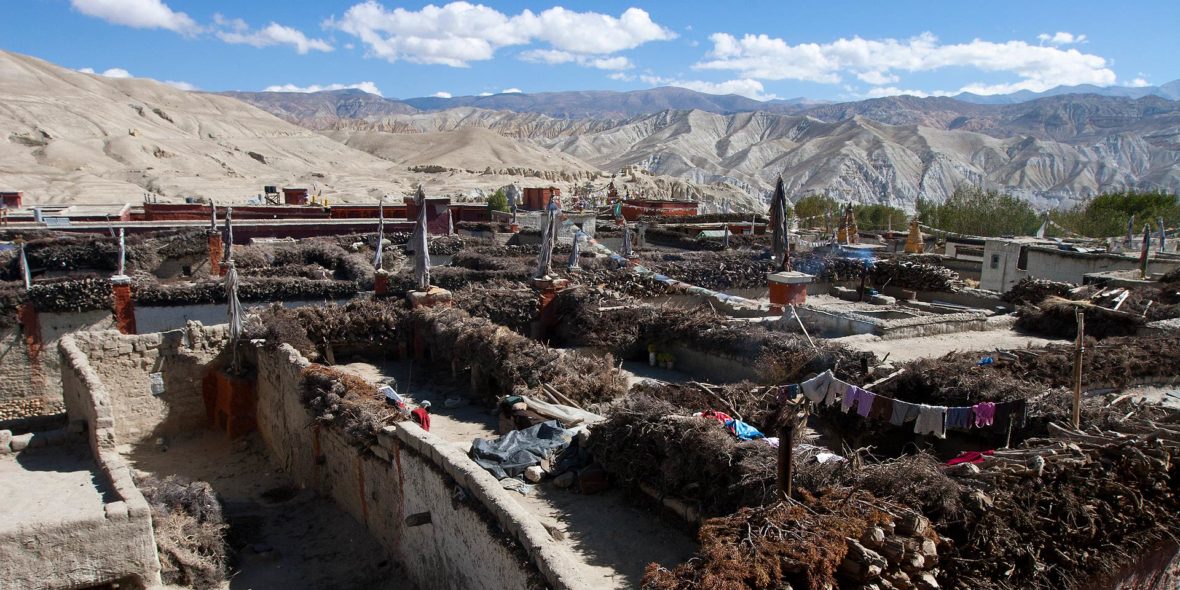
Day 10: Lo Manthang & The Chosar Valley
Today we’ll head out of Lo Manthang on a wide canyon trail, past dry gullies and an ancient, ruined fortress. Our destination: the cave village of Chosar and its deep-red Gharphu Gompa built into the rock face. This particular gompa is devoted to young initiates learning the foundations of monkhood, so get ready to meet some adorable, tiny students! Past the gompa is the ancient Jhong Cave, a 2,500-year-old dwelling site that we can navigate by climbing down ladders and through small tunnels.
The trail today is full of gurgling streams, green meadows, and a view of the small peaks that mark the border with Tibet. As we return to Lo, take in views of the Himalaya, particularly Annapurna, Tilicho and Nilgiri.
Walking time: Approx. 4-5 hours
Accommodation: Local Tea House
Meals included:
Breakfast, Lunch, Dinner
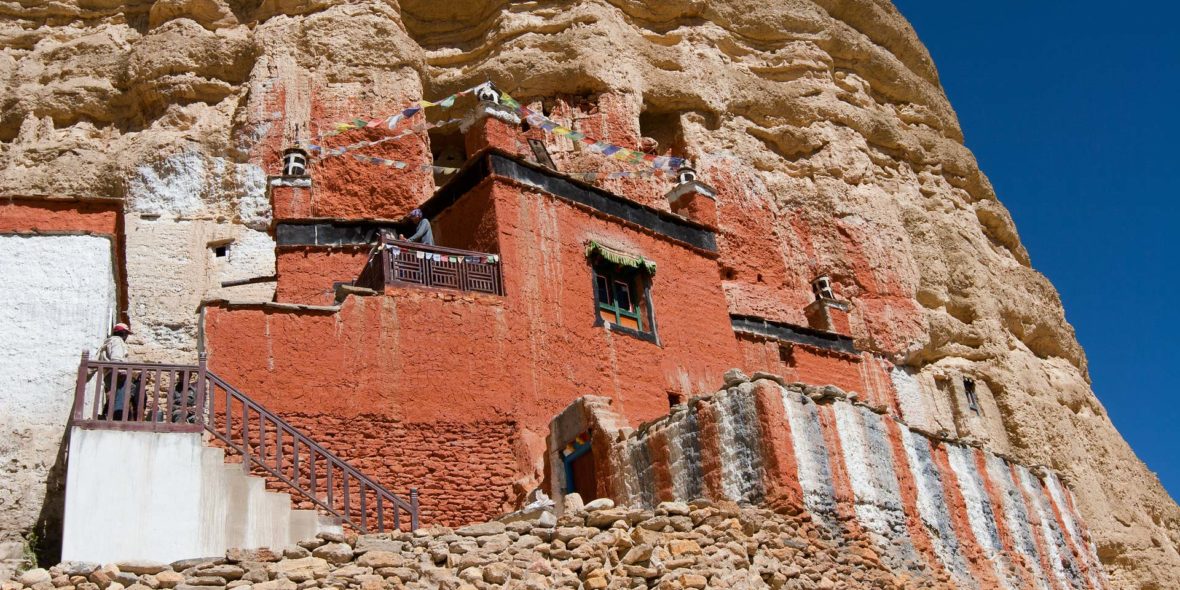
Day 11: Lo Manthang - Konchokling
We have one more outing from Lo Manthan today and we have possibly saved the best for last, the spectacular Konchokling. We hike up to the ancient caves in that red hoodoo country.
Walking time: Approx. 6 hours
Accommodation: Local Tea House
Meals included:
Breakfast, Lunch, Dinner
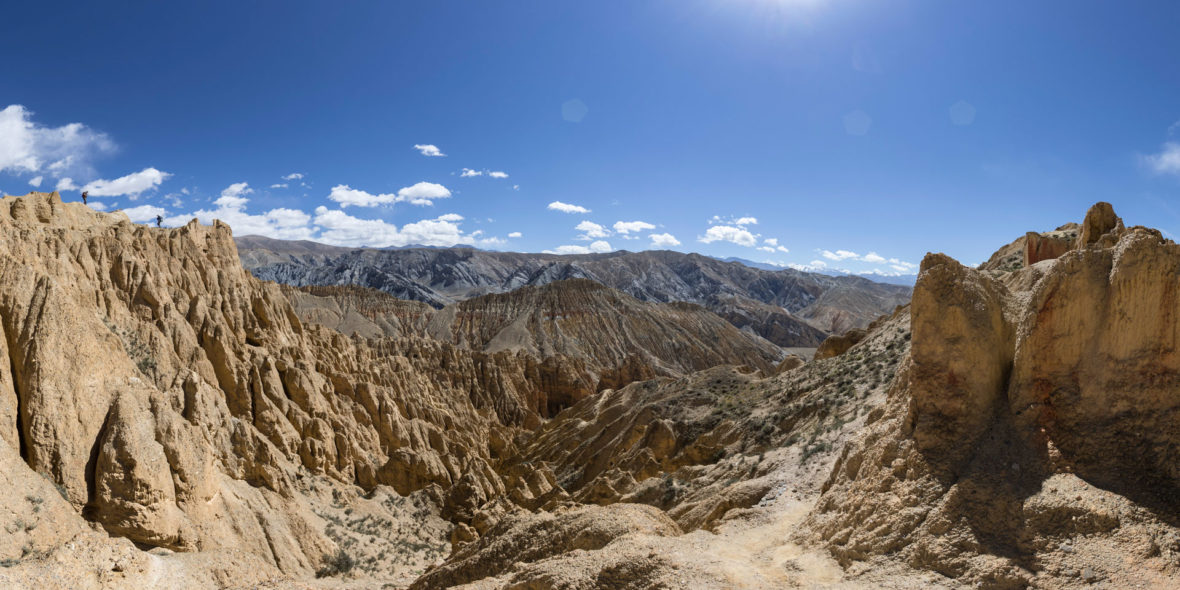
Day 12: Drive to Yara, Day Trek to Luri Gompa
We’ll leave magical Lo Manthang for a new adventure on our route south; we’ll drive back towards Tsarang, where we’ll take a much smaller alternative trail down to the Kali Gandaki and up a side valley to Yara.
From Yara, we’ll begin the next leg of our trek descending back to the Puyang Khola on a narrow trail; we’ll head east past fantastic, sculpted canyons where we can see the remains of a network of ancient caves. About two hours later, we’ll reach the amazing Luri Gompa and its complex of caves, some of which are accessible.
We may be able to visit a small gompa in the lower section, as well as the upper prayer-room, and the famous Kabum Stupa, which is filled with caves and wonderful murals. The Luri caves are filled with simply stunning Buddhist frescos and large, intricately painted chortens. Historians estimate them to be from the 13th or 14th century and linked to the Tashi Kumbum caves, one of a group of connected cave dwellings throughout this region. The style of painting is said to be similar to the Newar tangka style (of the Kathmandu Valley) and art historians speculate that the work was done by Nepali (possibly Newar) artisans, commissioned by Tibetans.
On the way back, we’ll take the high trail through the interesting village of Ghara, surrounded by terraced fields, before returning to Yara.
Driving time: 2 hours
Walking time: Approx. 4-5 hours
Accommodation: Local Tea House
Meals included:
Breakfast, Lunch, Dinner
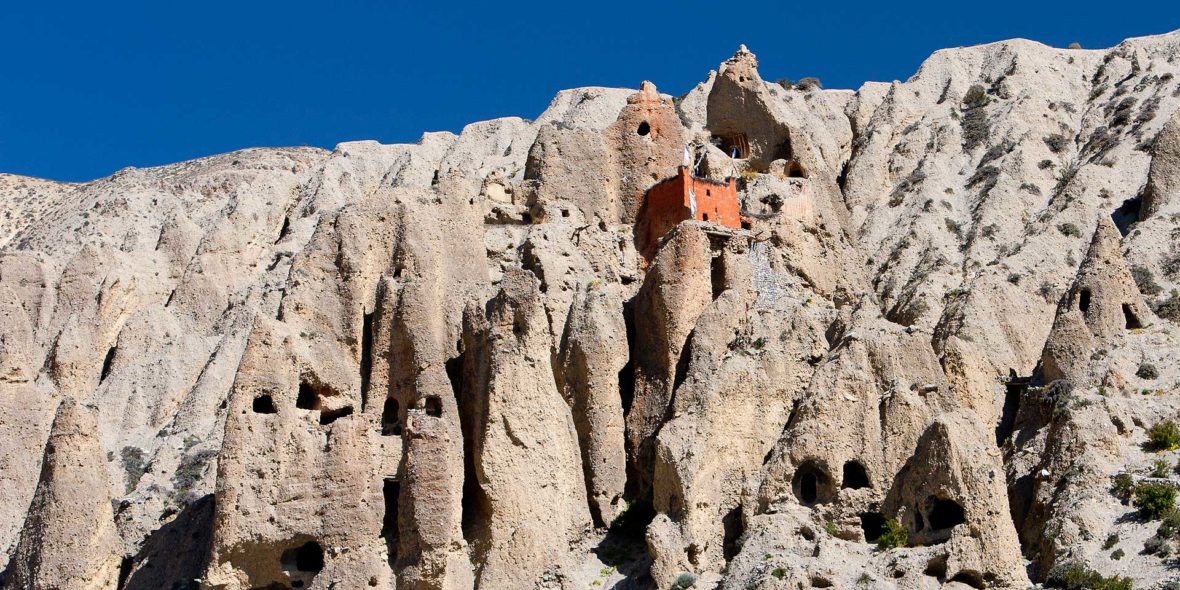
Day 13: Trek Tangye [3370m]
After a hearty breakfast and filling all our water bottles we head well and truly off the beaten path towards Tange. From Yara the trail follows the river for about 2 hours and then crosses a river that flows from Damodar Kunda, a sacred lake high above us to the east. There is no bridge across this river so we will need to get our tevas/sandals out and get our feet wet! After crossing the river, the trail climbs up to a pass at 3850m where we find ourselves in a desolate grassless, treeless and waterless hillside.
After the pass the trail again drops to Tange village at an elevation of 3370m, entering through the distinctive tri-colour chortens that are such a classic part of the Mustang landscape. Tange is a small village of around 30 houses; most those being attached to each other. On the rooftops one can see piles of dry wood and branches; this is juniper and is an auspicious sign of prosperity in this society. There is a beautiful view point in the village where we can look across a mass of chortens to the high mountains in Dolpo in the wild west.
Walking time: Approx. 6 hours
Accommodation: Local Tea House
Meals included:
Breakfast, Lunch, Dinner
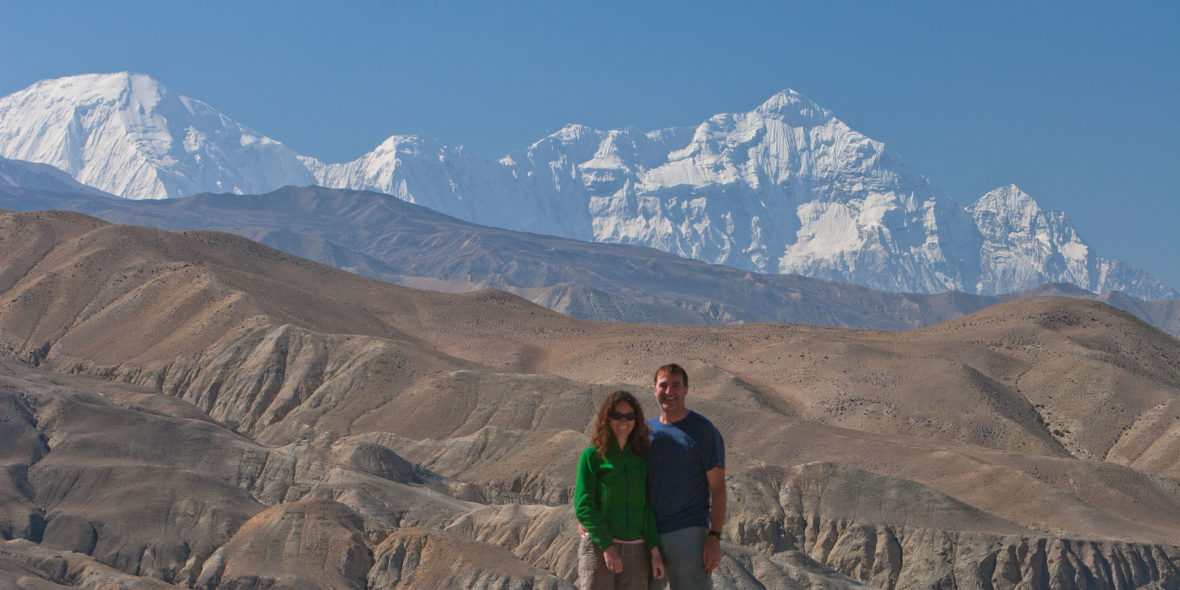
Day 14: Trek to Chhusang [2980m]
This morning we again make the most of a hearty breakfast as we have a long day ahead of us. Fill our water bottles, put a few energy bars in the pack and we hit the trail. We have a fine trail for about an hour and then stop to put our tevas on for a river crossing- should be nice and chilly! After crossing the river our trail climbs high up to reach the Cha Cho La (4200m) from where we can revel in an incredible view to many towering peaks including Dhaulagiri, Nilgiri, Tukche Peak, Tilicho Peak and Thorang Peak. Strangely enough, this area is one where we can see many varieties of flowers and if we are lucky we will see blue sheep. From the pass we plunge down to the Narshying Khola and down this river to Tetang, cleverly built between 2 hills to avoid the strong wind that hits the entire Kali Gandaki Valley on most days. Tetang is the upper village of the Chuksang, which we visit on the first day entering to Mustang from Kagbeni.
Walking time: Approx. 7-8 hours
Accommodation: Local Tea House
Meals included:
Breakfast, Lunch, Dinner
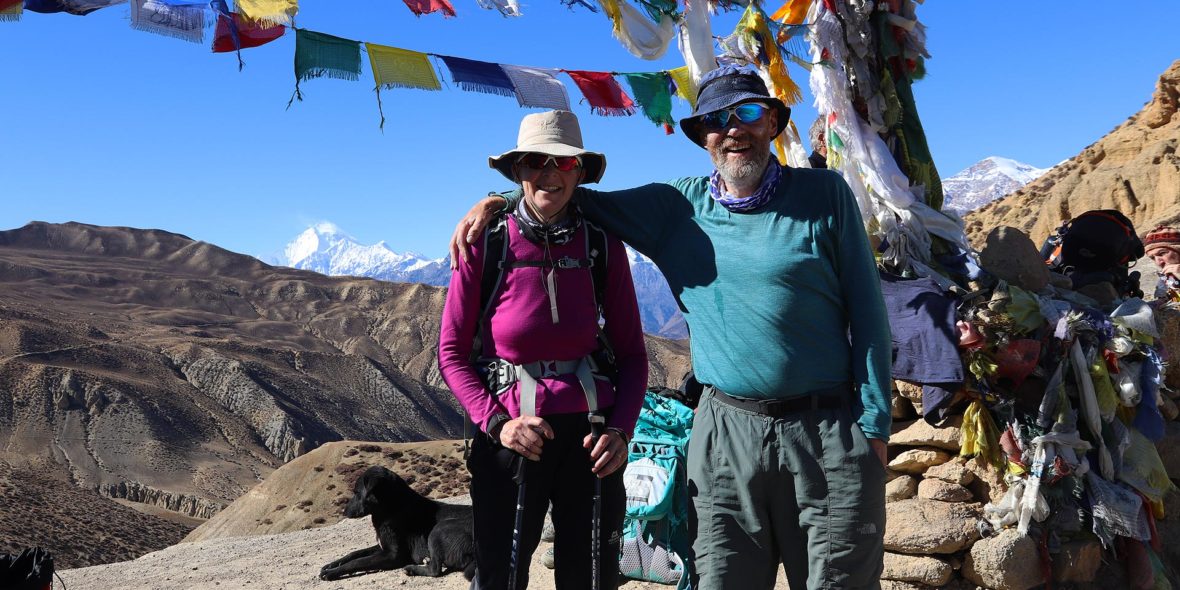
Day 15: Drive to Jomsom / Trek to Jomsom via Gyu La
We can jeep down to Jomsom or if you still have energy it might be possible to trek over the Gyu La to Muktinath and then jeep from there to Jomsom.
Taking the remote back route to Muktinath, we head up high again to cross the Gyu La (4075m) for incredible views down to Lower Mustang and the surrounding peaks. Thankfully it’s pretty much downhill from here on in and we descend to Muktinath where we have incredible views of Nilgiri and Mt. Tilicho to the southeast, Dhaulagiri to the southwest and Thorang peak and Yakawa Kang to the north.
Driving time: Approx. 2 hours
Walking time: Approx. 5-6 hours
Accommodation: Local Tea House
Meals included:
Breakfast, Lunch, Dinner

Day 16: Fly to Jomsom to Pokhara or Drive to Pokhara
Bid farewell to the Mustang as we head back to the greenery of the middle hills. We’ll have an early start to prepare for your spectacular 30-minute flight to Pokhara. There’s an option of driving back to Pokhara which takes approx. 10 hours to reach. After we land, we can spend the day however we like: there are myriad water activities (boating, kayaking, paddle-boating), yoga studios, and funky shops. Try paragliding if you’re feeling fearless or relax with a cocktail during happy hour at a café overlooking Phewa Lake.
Accommodation: Lake Side Retreat
Meals included:
Breakfast
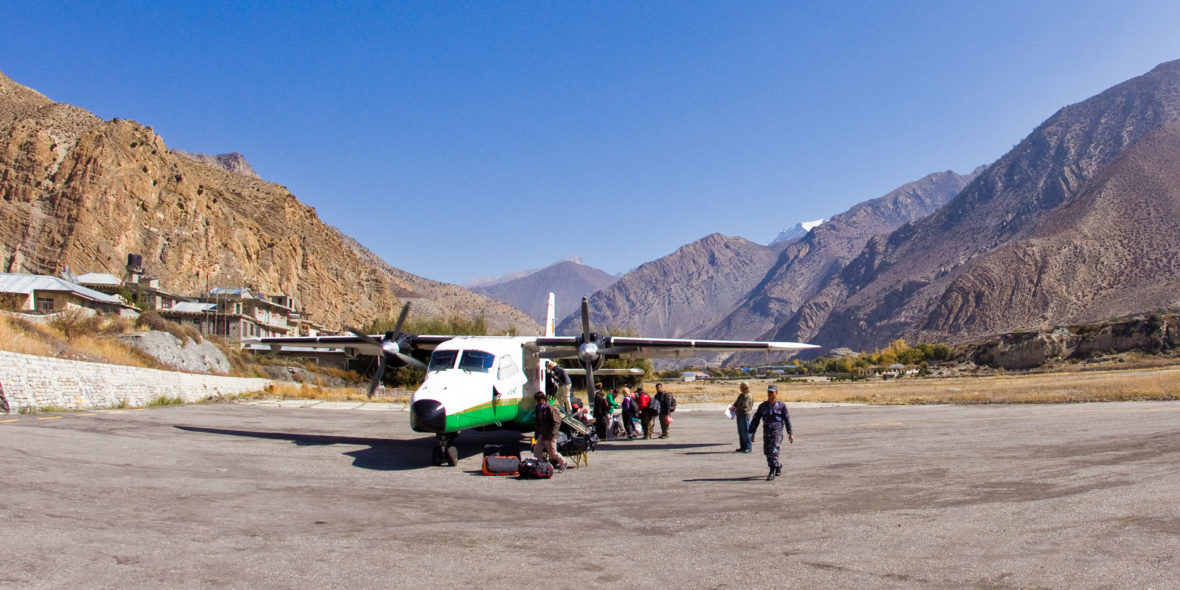
Day 17: Fly to Kathmandu and Spare day
Enjoy the morning in lovely Pokhara until we head to the airport for our flight back to Kathmandu; when we land in the capital, we’ll be picked up at the airport and transferred to our hotel.
The rest of the day is to relax on our own or head out for some final exploration in the colorful city of Kathmandu. Of course, our specialists can always give us some great ideas on how to spend the day:
- Vespa Tour: Take a unique tour on the back of a vintage Vespa, traveling in style. The Street Art Gallery tour and Nepali Food Safari are highly recommended. See www.vespavalley.com.
- City Sightseeing Tour: Kathmandu is home to seven UNESCO World Heritage sites and in a day we can visit three to four of them. Let your specialists know if we have any special interest and they can custom design something for you.
- Customized Shopping Tour: There are some fantastic designers and produces of homewares, clothing, accessories, pashminas, Tibetan carpets/furniture, trekking/outdoor gear, art (religious and contemporary), and much, much more. If retail therapy is right up our alley, our specialists can design a day according to your personal interest or can point you in the right direction of some of their favorite stores to explore on our own.
- Mountain Flight to Everest: This is the most spectacular flight with the closest possible aerial views of Mt. Everest and Kanchenjunga (the highest and the third highest Mountains in the world, respectively). This unique and awe-inspiring 1-hour flight also takes you past to Dorje-Lakpa, Chhoba-Bhamate, Gauri Shankar, Cho-Oyu, Pumori, Nuptse, Lhotse, and Amadablam.
Accommodation: Hotel Thamel House
Meals included:
Breakfast
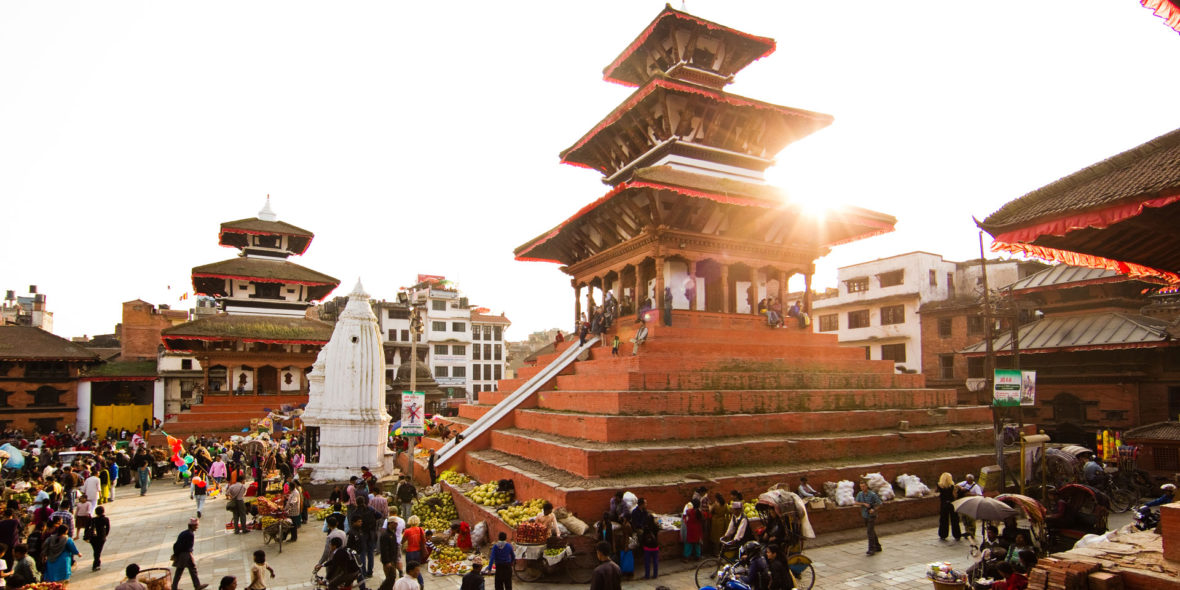
Day 18: Farewell for now
Enjoy a final breakfast at the hotel, tell one final round of tales about the trip, then we’ll transfer you to the airport, where we bid farewell and look forward to our paths crossing again.
Meals included: Breakfast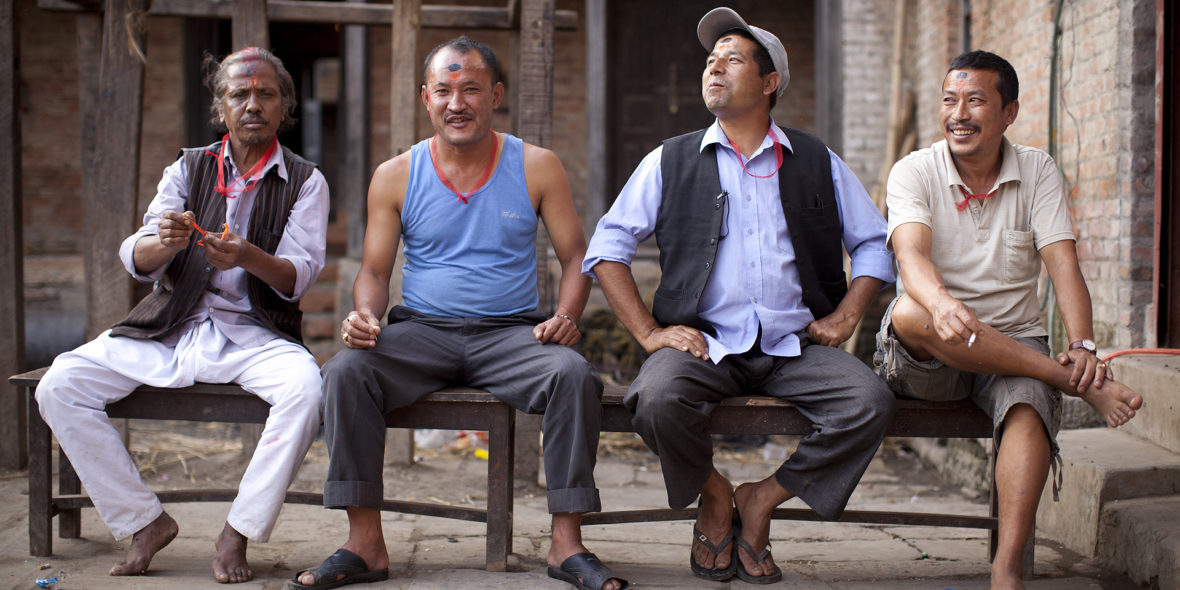
starting from US$ 2880.00$
Included In Price
• Hotel nights in a specified hotel in standard double/twin or single room on BB basis
• Tea house accommodation while on trek
• All meals on the trek (with filtered drinking water)
• Transport as per the itinerary including return flights from Kathmandu-Pokhara-Kathmandu, Pokhara-Jomsom-Pokhara including all taxes and transfers
• Your trekking guide and porter/s, with all their transport, equipment, insurance and including meals and accommodation
• A first aid kit appropriate for the group size and activities
• Trekking permits and registration fees (including the Upper Mustang Restricted Area Permit of US$550 for 11 days)
Note: The local tea houses are basic but clean and they do not often have attached bathrooms or hot showers. The price is based on twin share and does not include any extra charge that lodge owners may levy for single rooms, attached bathrooms or hot showers (if these facilities are available) or for battery charging. We can’t know in advance what they may charge for such things in the different lodges along the way, so we prefer to leave this cost out, rather than pass along an estimated charge to you.
The meal inclusions on trek are breakfast (one set breakfast and a tea or coffee), lunch (one main meal and a tea or coffee) and dinner (soup, main and dessert with a tea or coffee).
Not Included In Price
• Services and activities not mentioned in the detailed itinerary
• International flights to and from Kathmandu
• Nepal visa fees and international airport taxes
• Any gear or equipment that you may need to rent/buy
• Any excess baggage charges
• Single room supplement – please ask if you would like to have a single room (these are not always available in tea houses, but possible in the hotels/guest houses)
• Comprehensive travel insurance that includes trip cancellation and rescue evacuation should this be required for any reason (we require this as the minimum insurance cover); Rescue/evacuation costs (to be covered by your insurance)
• Additional nights, optional trips and sightseeing tours outside the detailed itinerary above
• Personal expenses (eg tips, soft drinks/bar bills, laundry, telephone calls, postage, donations, extra snacks, camera charges etc)
• Tips for your guide and drivers, please ask if you would like any guidance about this
• Costs incurred due to changes in programs and reservations due to unforeseen events (eg landslides, strikes, natural disaster,s large increase in fuel prices etc)




